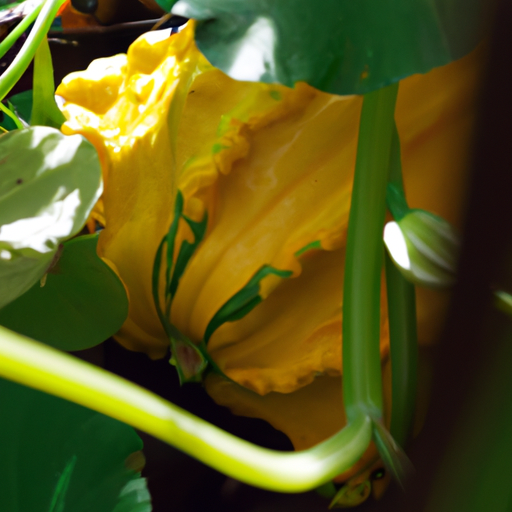Table of Contents
How to Plant Winter Squash in Your Garden

Are you ready to plant winter squash in your garden?
Planting winter squash is a great way to enjoy a delicious harvest in the fall. Here’s how to get started.
First, choose the right variety of winter squash for your garden. There are many types of winter squash, including acorn, butternut, and spaghetti squash. Consider the size of your garden and the amount of space you have available when selecting a variety. Butternut squash in particular take up a lot of room, so be aware of the space requirements.
Next, prepare the soil for planting. Winter squash needs well-drained soil that is rich in organic matter. Work in some compost or aged manure to help improve the soil’s fertility.
Once the soil is ready, it’s time to plant. Plant the seeds in hills or rows, spacing them about four to six feet apart. Plant the seeds about one inch deep and cover them with soil. Water the seeds thoroughly after planting.
Finally, care for your winter squash plants throughout the growing season. Water the plants regularly and fertilize them every few weeks. Keep an eye out for pests and diseases and take steps to control them if necessary.
With a little bit of care, you’ll be able to enjoy a delicious harvest of winter squash in the fall. Good luck!
Buy Seeds on Amazon
Tips for Growing Winter Squash in Colder Climates
Be aware of your first frost date and take care not to plant too late! Here’s a few more tips for those of you growing in colder climates this year.
1. Plant your winter squash in a sunny spot with well-draining soil. Make sure the soil is rich in organic matter and has a pH of 6.0 to 6.5.
2. Start your winter squash indoors in late spring and transplant them outside when the soil has warmed up and all danger of frost has passed.
3. Mulch your winter squash plants with straw or hay to help keep the soil warm and moist.
4. Water your winter squash plants regularly, especially during dry spells.
5. Protect your winter squash plants from cold temperatures by covering them with a row cover or cloche.
6. Harvest your winter squash when the rinds are hard and the stems are dry.
7. Store your winter squash in a cool, dry place.
Following these tips will help you successfully grow winter squash in colder climates. With a little extra care and attention, you can enjoy a bountiful harvest of winter squash this season! And hey if you’re short on room, get this trellis netting and go vertical with your garden:
The Benefits of Growing Winter Squash in Your Garden
If you’re looking for a delicious and nutritious vegetable to add to your garden this season, growing winter squash is definitely going to pack a ton of vitamins for you! Winter squash is a great addition to any garden, as it is easy to grow and provides a variety of health benefits. Here are some of the benefits of growing winter squash in your garden:
1. Nutritious: Winter squash is packed with vitamins and minerals, including vitamin A, vitamin C, potassium, and fiber. Eating winter squash can help you meet your daily nutritional needs and keep you feeling full and energized.
2. Versatile: Winter squash can be used in a variety of dishes, from soups and stews to roasted vegetables and salads. You can also use it to make delicious desserts like pumpkin pie or squash bread.
3. Easy to Grow: Winter squash is relatively easy to grow in most climates. It requires minimal maintenance and can be harvested in the fall.
4. Long-Lasting: Winter squash can be stored for several months, so you can enjoy it all winter long.
Growing winter squash in your garden is a great way to add a nutritious and delicious vegetable to your diet. Plus, it’s easy to grow and can be stored for months, so you can enjoy it all winter long. So why not give it a try this season?
Common Pests and Diseases to Look Out For When Growing Winter Squash
When growing winter squash, it’s important to be aware of common pests and diseases that can affect your crop. Here are some of the most common ones to look out for with squash plants:
1. Squash bugs: These bugs feed on the leaves and stems of squash plants, causing them to wilt and die. They can also spread diseases. To prevent them, keep your garden clean and free of debris, and use row covers to protect your plants.
2. Powdery mildew: This fungal disease causes a white, powdery coating on the leaves of squash plants. To prevent it, make sure your plants have plenty of air circulation and avoid overhead watering.
3. Cucumber beetles: These beetles feed on the leaves and stems of squash plants, causing them to wilt and die. To prevent them, use row covers and keep your garden clean and free of debris.
4. Bacterial wilt: This bacterial disease causes the leaves of squash plants to wilt and die. To prevent it, make sure your plants have plenty of air circulation and avoid overhead watering.
5. Fusarium wilt: This fungal disease causes the leaves of squash plants to wilt and die. To prevent it, make sure your plants have plenty of air circulation and avoid overhead watering.
By being aware of these common pests and diseases, you can take steps to protect your winter squash crop and ensure a successful harvest.




